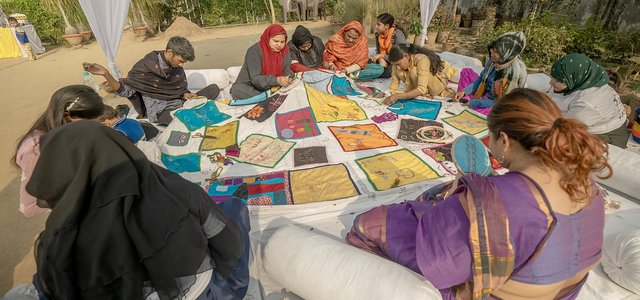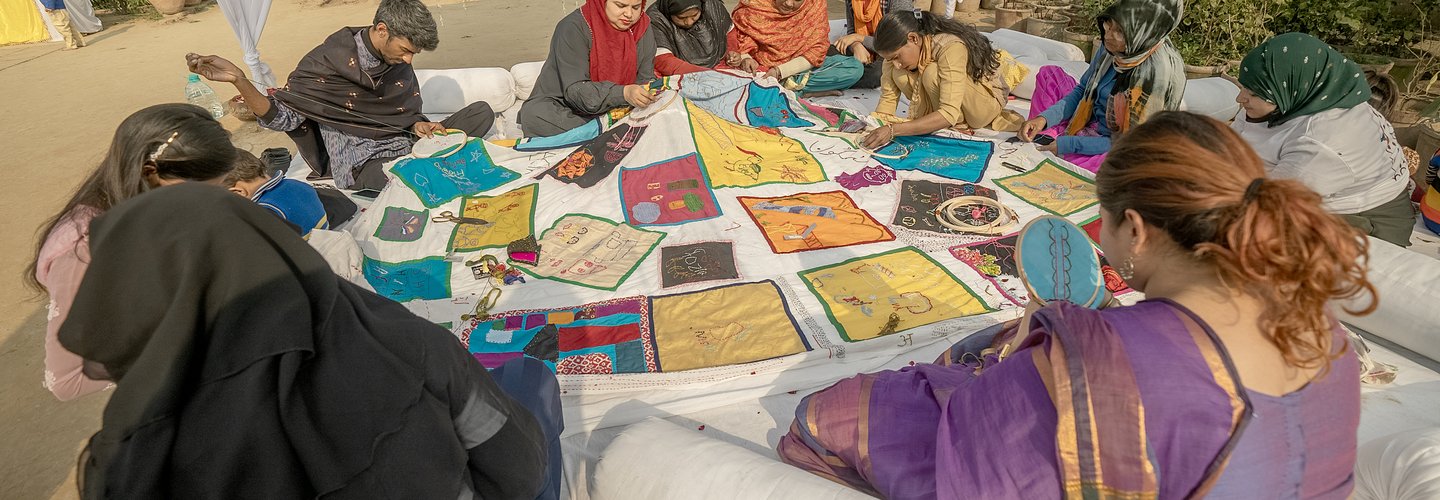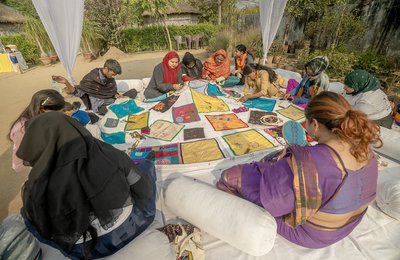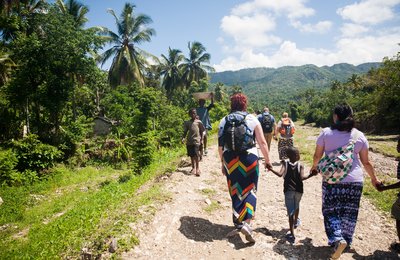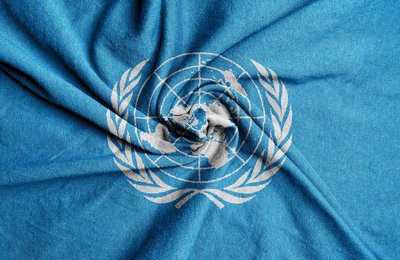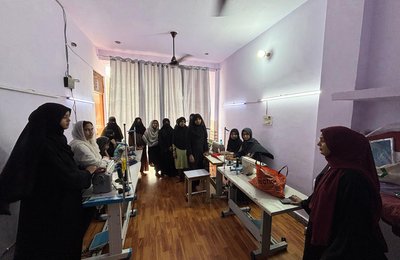The House That Mends: Articulating identity and stories through thread
Every Sunday, women in New Delhi’s Shaheen Bagh neighbourhood are narrating their personal stories through thread. Rafooghar (The House That Mends, derived from Rafu gar: clothes mender or darner) is a safe space that, since the summer of 2023, has supported marginalised, underprivileged Delhi women to gather and articulate their shared stories of friendship, freedom, leisure, self-care, and identity through the medium of embroidery. The initiative is supporting personal healing, social cohesion, and independence for these women, but it has also challenged gender norms.
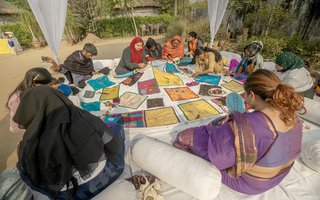
The origin of Rafooghar
The founder, Delhi-based Pooja Dhingra, had been documenting stories of compassion, solidarity and resilience among ordinary citizens through art during the pandemic via her online archive, Compassion Contagion which she created with activist, Nida Ansari. Meanwhile, having experienced personal trauma with her father’s illness, Dhingra and her mother found solace in embroidery’s meditative and therapeutic qualities.
She then connected with Yusra Khan, the founder of Yellow Streets, a non-profit working with women and children of Shaheen Bagh, Madhanpur Khadar, and Jasola Vihar, which uses sports, education, and arts as agents of change. Pooja and Yusra worked on an online toolkit, Stitching Futures as part of Compassion Contagion’s Manifesto For Future. The toolkit was designed in collaboration with Rubina Singh, an embroidery activist and Roshni Bhatia, an art therapist to build solidarity and imagine alternative feminist futures in a post-COVID world, and so that people could download it and access it offline. Embroidery was a core component of the toolkit. Having initially tested it during an in-person workshop and received a great response, Dhingra felt the need to work closely with the community on the ground a year later.
She gravitated towards Shaheen Bagh because the area had witnessed powerful, peaceful women-led protests against the Citizenship (Amendment) Act (CAA) in December 2019, when women had also displayed their art during the protests. Collaborating with Khan, who was already working there, the neighbourhood became the site of Rafooghar gatherings, growing from a room into a larger space over time. And so, a diverse community of women, all of different religion, region, caste and occupations - including daily-wage earners, domestic workers, and homemakers from the area, from Jasola and Madhanpur Khadar - gathered every Sunday to share and stitch their stories.
Stitching together
While the women came from different socio-cultural backgrounds, such as Hindu and Muslim, they had shared struggles, including having experienced sexual and gender-based violence, or husbands having abandoned them and their children, for example.
“They really bonded over the difficulties they were facing at home,” Dhingra says, emphasising that it was not just stitching of stories which was therapeutic, but also sharing stories with one another.
These women have otherwise limited mobility in the city and lead confined lives. While the women’s families perceived embroidery as uncontroversial, unlike dancing or singing, and associated with sewing skills, which women are traditionally expected to have, there were still access challenges. Nevertheless, initially it was difficult for women to continue returning to the gatherings.
“Children would accompany them, husbands would suddenly call them to return, or they themselves didn’t understand the point of participating with no economic incentive,” Dhingra says, adding that few women still consistently showed up and have stayed until this day.
What ultimately matters is that women find strength and solidarity in sharing their stories, which culminate in thread narratives.
“Someone will share something very personal and that will to sustain the vulnerability encourages others to share too,”[1] Khan says, mentioning that the women’s ability to trust the space was crucial. “For example, there was a lady who shared her journey through divorce and remarriage and said, ‘No one was thinking about my life so I had to think about it.’”
Sharing such stories and participating in modules that encourage them to think more deeply about their aspirations and individual qualities becomes a catalyst to deeply ask themselves: where is ‘me’ in my entire world? Furthermore, given Rafooghar greatly emphasises rest, leisure, and restoration, it has also led to necessary conversations about these themes, which were practically alien to the women.
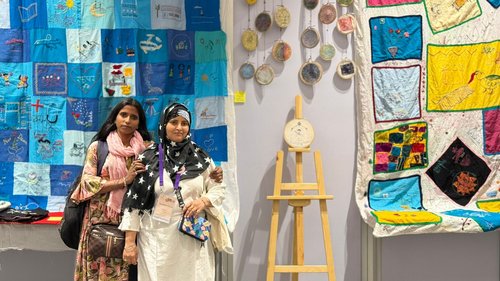
Moni and Gulafsha at AWID, Thailand. Credit: Rafoo Ghar, 2025
“Our hearts become lighter”
Embroidery becomes a powerful portal for women to articulate and unburden themselves, as Dhingra mentions the women say, “Hamara jee halka hota hai, mann ki bhadaas nikal jaati hai (Our hearts become lighter, we can vent).”
Through sharing and stitching stories, the women also created a space for friendship, which they sorely lacked in their lives. A sixteen-year-old fleeing a violent marriage found safety and solidarity in this space and in embroidery too, before eventually gathering the strength to file a case against her abusive husband and in-laws.
“From inception, Rafooghar has been individual-centric, focusing on personal narratives which eventually became a collective,” Khan says. This was literally embodied in the Love Lihaaf (Love Quilt) module, where women partnered with each other, listened to their stories, and embroidered story cloths which then collectively became a lihaaf (quilt). In another module, Meri Pehchaan (My Identity) the women were invited to share their aspirations, hopes, and dreams through expressive portraits.
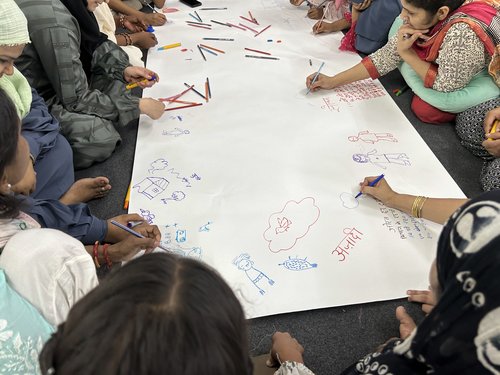
Credit: Rafoo Ghar, 2025
Khan explains the modules respond to women’s needs emerged from the previous sessions. Designing modules is an entirely democratic process. “Every Rafooghar decision is co-led and taken equally,” she states, adding that the space’s egalitarian nature is why the women say they keep on returning to Rafooghar.
Some of the modules have been designed in collaboration with Shivangi Singh -an art educator from Artreach India. Many independent embroidery artists, educators and art therapists also come to Rafooghar to facilitate modules on various themes, incorporating theatre and movement-based activities among other approaches.
Apart from the women, one boy, Hariom also displayed interest from the very beginning, having earlier been bullied for his interest in embroidery. He, Dhingra and art educator Achal Dodia have recently received a grant for the module, ‘Meethi Baradari’ (Sweet Brotherhood’) which interrogates the idea of the very feminine embroidery practice as a tool for redefining masculinity and societal gender norms.
Dhingra and Khan emphasise that a crucial reason for which many of the women come to the Rafooghar community is because “humein yahan izzat milti (we receive respect here)” which unfortunately their husbands or families do not show them. Their opinions and thoughts matter here. Given that most of the women have limited or no literacy, embroidery literally becomes a language which conveys their deepest truths and dreams for them, translating their thoughts into tangible realities.
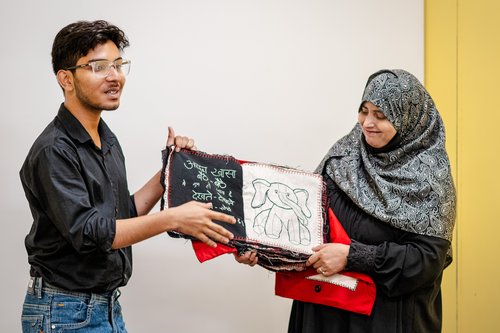
Hariom and Gulafsha at a workshop at KNMA. Credit: Rafoo Ghar, 2025

